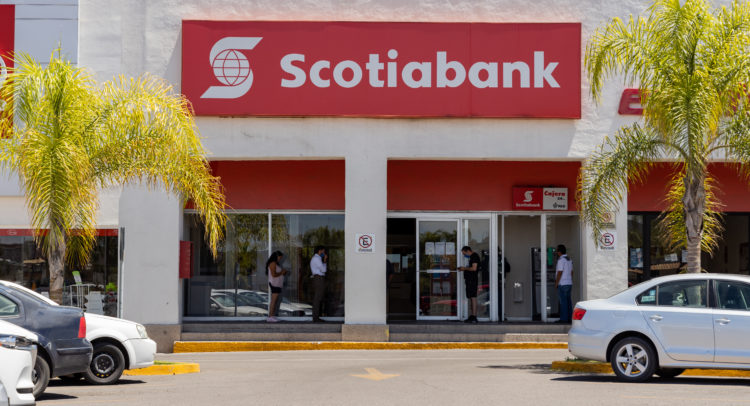When it comes to reliable dividends, there are probably no better investments than Canadian banks. Why? Given the highly regulated nature of Canada’s banking industry, the large Canadian banks have delivered stellar earnings and returns for decades.
Claim 70% Off TipRanks This Holiday Season
- Unlock hedge fund-level data and powerful investing tools for smarter, sharper decisions
- Stay ahead of the market with the latest news and analysis and maximize your portfolio's potential
In fact, the nature of the Canadian system allowed the banks to outperform their global peers during the 2008 Financial Crisis. While dividend cuts were prevalent during this time, not even one of Canada’s big banks cut its dividend.
There is also a little-known strategy that can lead to outsized returns. History has shown that the worst performing of Canada’s Big Five banks has gone on to outperform in the year that follows.
Today, that distinction falls to the Bank of Nova Scotia (BNS). I am neutral on the stock. (See Analysts’ Top Stocks on TipRanks)
Worst Performing Bank
Year-to-date, the Bank of Nova Scotia is up by approximately 22%. However, the company’s underperformance sticks out when you compare it to its Canadian Big Bank peers, which are up by an average of 34% this year.
Why the underperformance? The Bank of Nova Scotia has had a difficult time living up to growth expectations. Over the past few years, it has failed to beat analysts’ annual consensus estimates while its peers are regularly topping expectations.
The main headwind facing the Bank of Nova Scotia is the company’s International segment. Post-Financial Crisis, the bank spent big on making acquisitions worldwide. In fact, it was one of the fastest growing banks in Canada as it spent heavily to expand in Latin America, the Caribbean and Asia.
Unfortunately, the company may have spread itself a little too thin and in 2018, management announced a refocused international strategy centered on its larger markets.
That led to the disposition of assets in smaller countries as it looked to narrow down the number of international markets in which it operated. This took much longer than expected and as a result, international operations became a drag on financials.
The good news is that the company came out with a much more focused international strategy and one that was centered Latin America. The bad news is that the pandemic hit, and countries in Latin America were hit particularly hard. Not only were they severely impacted, but vaccine rollouts and economic re-openings have taken much longer than in North America.
Potential Upside Catalyst
Where do investors go from here? An argument can be made that the Bank of Nova Scotia offers outsized potential.
Since operations in Latin America have lagged those in North America, there is more runway to benefit from an economic rebound in those countries. That can be the catalyst the bank needs to turn the International segment from a headwind to a tailwind.
Furthermore, the bank recently announced that it is looking to beef up its wealth-management presence in the U.S., and is on the hunt for acquisitions. While the size of any acquisition is unlikely to be a transformative one, tuck-in acquisitions in this area can be quite lucrative.
Top Dividend Stock
While investors wait for the company’s International segment to deliver, they currently enjoy a 6% yield which is one of the highest in the industry. As mentioned earlier, it is also one of the most reliable dividend payers in North America.
At the onset of the pandemic, the Office of the Superintendent of Financial Institutions (OSFI) capped dividend raises for Canada’s Banks. While investors wait patiently for dividend growth to resume, the Bank of Nova Scotia is well positioned to resume dividend growth once the cap is lifted.
To put the company’s reliability into perspective, the Bank of Nova Scotia has raised dividends in 43 of the past 45 years. The only interruptions came during the Financial Crisis and the current pandemic. Further cementing its status as one of the best income stocks to own, the Bank of Nova Scotia has paid out uninterrupted dividends since 1833. That is almost 200 years of continuous payments.
Sure, the past is not an indicator of future success but when it comes to the commitment to the dividend, investors would be hard pressed to find any better.
Wall Street’s Take
From Wall Street analysts, the Bank of Nova Scotia earns a Moderate Buy analyst consensus based on five Buy ratings, four Hold ratings, and no Sell ratings.
The average Scotiabank price target of C$86.97 puts the upside potential at 5.3%.

Disclosure: At the time of publication, Mat Litalien did not have a position in any of the securities mentioned in this article.
Disclaimer: The information contained in this article represents the views and opinion of the writer only, and not the views or opinion of TipRanks or its affiliates, and should be considered for informational purposes only. TipRanks makes no warranties about the completeness, accuracy or reliability of such information. Nothing in this article should be taken as a recommendation or solicitation to purchase or sell securities. Nothing in the article constitutes legal, professional, investment and/or financial advice and/or takes into account the specific needs and/or requirements of an individual, nor does any information in the article constitute a comprehensive or complete statement of the matters or subject discussed therein. TipRanks and its affiliates disclaim all liability or responsibility with respect to the content of the article, and any action taken upon the information in the article is at your own and sole risk. The link to this article does not constitute an endorsement or recommendation by TipRanks or its affiliates. Past performance is not indicative of future results, prices or performance.
















